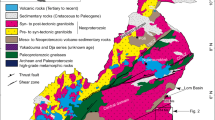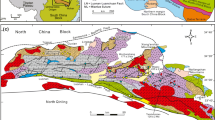Summary
Ankerite, siderite, calcite and magnesite occur in variable proportions within all host and mineralized rocks of the Bogosu and Prestea mining districts of the Ashanti Gold Belt, Ghana. The compositions of coexisting ankerite-siderite grains establish that complex rhythmically zoned growth banding and replacement textures are present. This compositional variation is attributed to episodic fluctuation in the temperature and composition of fluids in the Bogosu-Prestea mesothermal gold system. Temperatures derived from the ankerite-siderite composition geothermometer are generally consistent with those from calcite-dolomite, arsenopyrite, carbon and oxygen stable isotope, and fluid inclusion geothermometers, and are about 360°C for the metamorphic peak, 400 to 350°C for carbonate alteration of mafic dikes, and 340 to 140°C for gold deposition. The latter range occurs on a thin-section scale and represents separate pulses of fluid in the ore conduit.
Zusammenfassung
In allen Wirtsgesteinen und mineralisierten Gesteinen der Bergbaureviere von Bogosu und Prestea im Ashanti Gold Belt, Ghana treten Ankerit, Siderit, Calcit und Magnesit in unterschiedlichen Verhältnissen auf. Die Zusammensetzung von koexistierenden Ankerit-Siderit-Körnern zeigt eine komplexe, rhythmisch zonierte Wachstumsstreifung und Verärdngungsstrukturen. Diese Änderungen in der Zusammensetzung sind auf episodische Fluktuationen der Temperatur und der Zusammensetzung der Fluide im mesothermalen Goldsystem von Bogosu-Prestea zurückzuführen. Temperaturen nach dem Ankerit-Siderit-Geothermometer stimmen im allgerneinen mit jenen aus Geothermometern, die auf Calcit-Dolomit, Arsenopyrit, den stabilen Isotopen von Kohlenstoff and Sauerstoff und auf Flüssigkeitseinschlüssen beruhen, überein. Sie liegen bei rund 360°C für den Höhepunkt der Metamorphose, bei 400 bis 350°C für die Karbonat Alteration der matischen Gänge and bei 340 bis 140°C für die Gold-Fällung. Der letztgenannte Bereich tritt in Dünnschlif Maßstab auf and repräsentiert einzelne Schübe von Fluid in den Erzgängen.
Similar content being viewed by others
References
Abouchami W, Boher M, Michard A, Albarede F (1990) A major 2.1 Ga event of mafic magmatism in West Africa: an early stage of crustal accretion. J Geophys Res 95: 17,605–17,629
Anovitz LM, Essene EJ (1987) Phase equilibria in the system CaCO3-MgCO3-FeCO3. J Petrol 28: 389–414
Barron BJ (1974) The use of coexisting calcite-ankerite solid solutions as a geothermometer. Contrib Mineral Petrol 36: 147–154
Bickle MJ, Powell R (1977) Calcite-dolomite geothermometry for iron-bearing carbonates. Contrib Mineral Petrol 59: 281–292
Colvine AC, Fyon JA, Heather KB, Marmont S, Smith PM, Troop DG (1988) Archean lode gold deposits in Ontario. Mines, Minerals Div, Ontario Geol Surv, Misc Paper 139, 136 p
Essene EJ (1983) Solid solutions and solvi among metamorphic carbonates with applications to geologic thermometry. In:Reeder RJ (ed) Carbonates: mineralogy and chemistry. MSA Rev Mineral 11: 77–96
Goldsmith JR, Newton RC (1969) Calcite-dolomite geothermometry for iron-bearing carbonates. Contrib Mineral Petrol 59: 281–292
Goldsmith JR, Witters J, Northrup DA (1962) Studies in the system CaCO3-MgCO3-FeCO3: a method for major-element spectrochemical analysis. 3. Composition of some ferroan dolomites. J Geol 70: 659–687
Harker RI, Tuttle OF (1955) Studies in the system CaO-MgO-CO2, part 2. Limits of the solid solution along the binary join CaCO3-MgCO3. Am J Sci 253: 274–282
Hastings DA (1982) On the tectonics and metallogenesis of West Africa: a model incorporating new geophysical data. Geoexplor 20: 295–327
Hutcheon I, Moore JM (1973) The tremolite isograd near Marble Lake, Ontario. Can J Earth Sci 10: 936–947
Junner NR (1940) Geology of the Gold Coast and Western Togoland. Ghana Geol Surv, Bull No. 11
Kesse GO (1985) The mineral and rock resources of Ghana. Balkema, Rotterdam, 610p
Klemd R, Hirdes W, Olesch M, Oberthür T (1993) Fluid inclusions in quartz-pebbles of the gold-bearing Tarkwaian conglomerates of Ghana as guides to their provenance area. Mineral Deposita 28: 334–343
Kretschmar U, Scott SD (1976) Phase relations involving arsenopyrite in the system Fe-As-S and their application. Can Mineral 14: 364–386
Leonardos OH, Jost H, Oliveira GG (1991) Gold deposits and shear zone relationships in the Precambrian of Brazil. In:Ladeira EA (ed) Brazil Gold 91, pp 167–169
Leube A, Hirdes W, Mauer R, Kesse GO (1990) The Early Proterozoic Birimian Supergroup of Ghana and some aspects of its associated gold mineralization. Precam Res 46: 139–165
Mumin AH (1994) Early Proterozoic Birimian gold mineralization of the Bogosu and Prestea districts of the Ashanti Gold Belt, Ghana, West Africa. Thesis, University of Western Ontario, 312p (unpub)
Mumin AH, Fleet ME, Chryssoulis SL (1994) Gold mineralization in As-rich mesothermal gold ores of the Bogosu-Prestea mining district of the Ashanti Gold Belt, Ghana: remobilization of “invisible” gold. Mineral Deposita 29: 445–460
Mumin AH, Fleet ME, Longstaffe FJ (1995) Evolution of hydrothermal fluids in the Ashanti Gold Belt, Ghana: stable isotope geochemistry of carbonates, graphitic material and quartz Econ Geol (submitted)
Nesbitt BE, Essene EJ (1982) Metamorphic thermometry and barometry of a portion of the southern Blue Ridge province. Am J Sci 282: 701–729
Oberthtür T, Schmidt Mumm A, Vetter U, Weiser Th, Amanor JA, Gyapong WA, Kumi R, Blenkinsop TG, Chryssoulis S (1993) The Ashanti Goldfields Mine, Ghana: mineralogical characteristics, light stable isotopes and fluid properties.Fenoll Hach-Ali J, Torres-Ruiz J, Gervilla F (eds) Current research in geology applied to ore deposits. Proceedings of the Second Biennial SGA Meeting, Granada, pp 523–526
Pan Y, Fleet ME (1992) Calc-silicate alteration in the Hemlo gold deposit, Ontario: mineral assemblages, P-T-X constraints, and significance. Econ Geol 87: 1104–1121
Panteleyev A (1990) Gold in the Canadian Cordillera — a focus on mesothermal and epithermal environments. In: Ore Deposits, Tectonics and Metallogeny in the Canadian Cordillera, GAC/MAC Short Course
Phillips GN, Brown IJ (1987) Host rock and fluid control on carbonate assemblages in the Golden Mile dolerite, Kalgoorlie gold deposit, Australia. Can Mineral 25: 265–273
Powell R, Condliffe DM, Condlie E (1984) Calcite-dolomite geothermometry in the system CaCO3-MgCO3-FeCO3: an experimental study. J Metam Geol 2: 33–41
Robert F (1991) Gold metallogeny of greenstone belts: considerations from the eastern Abitibi subprovince, Canada. In:Ladeira EA (ed) Brazil Gold 91, pp 31–47
Rosenberg PE (1967) Subsolidus relations in the system CaCO3-MgCO3-FeCO3 between 350 and 550°C. Am Mineral 52: 787–797
Sample JC, Moore JC (1987) Structural style and kinematics of an underplated slate belt, Kodiak and adjacent islands, Alaska. GSA Bull 99: 7–20
Sandiford M, Keays RR (1986) Structural and tectonic constraints on the origin of gold deposits in the Ballarat Slate Belt, Victoria. In:Keppie JD, Boyle RW, Haynes SJ (eds) Turbidite-hosted gold deposits. GAC Special Paper 32: 15–24
Sestini G (1973) Sedimentology of a paleoplacer: the gold-bearing Tarkwaian of Ghana. In:Amstutz GC, Bernard AJ (eds) Sedimentary ores. Springer, Berlin Heidelberg New York, pp 275–305
Sharp ZD, Essene EJ, Kelly WC (1985) A re-examination of the arsenopyrite geothermometer: pressure considerations and applications to natural assemblages. Can Mineral 23: 517–534
Talantsev AS,. Sazonov VN (1979) Variations in compositions of coexisting dolomiteankerite and magnesite-siderite as an index of PT-conditions of mineral formation. Akad Nauk SSSR Ural'skii Nauchaii Tzentr, pp 95–103
Taylor PN, Moorbath S, Leube A, Hirdes W (1992) Early Proterozoic crustal evolution in the Birimian of Ghana: constraints from geochronology and isotope geochemistry. Precam Res 56: 97–111
Author information
Authors and Affiliations
Rights and permissions
About this article
Cite this article
Mumin, A.H., Fleet, M.E. Evolution of gold mineralization in the Ashanti Gold Belt, Ghana: Evidence from carbonate compositions and parageneses. Mineralogy and Petrology 55, 265–280 (1995). https://doi.org/10.1007/BF01165121
Received:
Accepted:
Issue Date:
DOI: https://doi.org/10.1007/BF01165121




